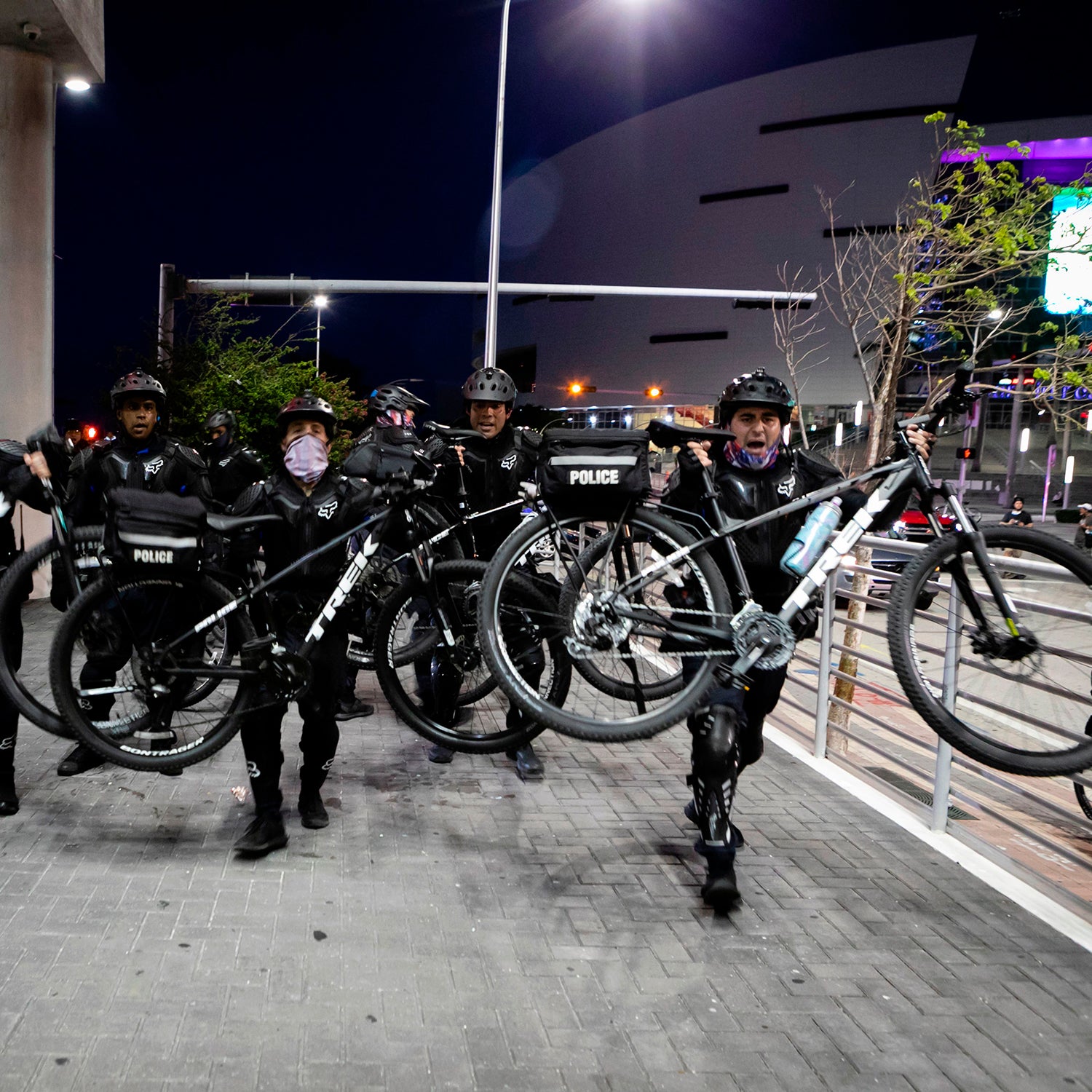On May 28, showing a New York Police Department (NYPD) officer hoisting his bicycle, thrusting it violently into a crowd of Black Lives Matter protesters, and then flattening human beings with it as if tamping espresso. Another video, posted more than a week later, saw police in Seattle using their bikes to running from tear gas explosions. Yet another featured footage of a group of bicycle cops in Philadelphia with batons.
These are just a few of the images that have appeared on social media in recent weeks documenting police using their bikes to , prompting outrage across the country. As a result, Fuji’s North American distributor has of bicycles to police departments, while Trek Bikes, amid calls for the company to follow suit, decrying police use of its bicycles as “abhorrent.”
While the bike has changed the world for the better, like any powerful tool, it also holds tremendous potential for weaponization. Police have used bicycles to patrol the streets since at least 1895, when then New York City police commissioner Teddy Roosevelt a crack team of cyclists to apprehend speeders in carriages. In his autobiography, how the Scorcher Squad, as it was known,“frequently stopped runaways, wheeling alongside of them, and grasping the horses while going at full speed.”
During the last two decades, police departments the bicycle as a tool for crowd control. In 2018, the Police Executive Research Forum, a nonprofit think tank, published called “The Police Response to Mass Demonstrations: Promising Practices and Lessons Learned.” The report calls bicycle officers a “critical resource in mass demonstrations” and says that they are “often seen as less intimidating than other officers and, therefore, are able to engage with protesters more easily.”
But as we’ve seen in the recent videos, certain police departments have transformed the benign act of cycling into a show of force, even with opening-credit-sequence precision. (Though things in practice.)
It feels jarring to see the bicycle used in tandem with batons and pepper spray, especially given its long history as an agent of positive change. Indeed, for every bike boom over the past century and a quarter, there’s been a corresponding shift in social consciousness. At the , in 1896—one year after Roosevelt commissioned the Scorcher Squad— that the bicycle “has done more to emancipate women than anything else in the world. It gives women a feeling of freedom and self-reliance. I stand and rejoice every time I see a woman ride by on a wheel… the picture of free, untrammeled womanhood.” During this same period, suffragist Elizabeth Cady Stanton that the bicycle would “inspire women with more courage, self-respect, and self-reliance and make the next generation more vigorous of mind and of body.” The bicycle upended previously held notions about how women should dress and behave, ushering in a new era of fitness, freedom, and (gasp!) exposed ankles, thereby paving the way for women’s suffrage.
In the 20th century, the bicycle rose again to challenge the primacy of the automobile. As America underwent suburbanization (a process driven by ), cars came to dominate the roadways; in the postwar years, cities disinvested in public transit, and bicyclists and pedestrians were forced into the margins. During this period, to stop cars from ravaging their neighborhoods and killing their children. In the seventies, baby boomers responded to the environmental and health concerns brought by autocentrism with more activism and another . Bike sales from six million a year to more than 15 million a year from 1970 to 1972, the federal government a network of bikeways, and protesters in cities across America marched (or, rather, rode) for cleaner air and safer streets.
The bicycle remained the vehicle of choice for protesters in the following decades. The was born in 1992 in San Francisco as a demonstration of the “safety in numbers” concept, in which a higher density of bikes make the streets safer for bicyclists. By the 21st century, the Critical Mass ride had spread around the world. In 2004, the NYPD in one that coincided with the Republican National Convention. Following the arrests, the city intended to outlaw large gatherings like Critical Mass, and in 2007, the arrested riders filed a class-action lawsuit, which the City of New York for nearly $1 million.
Meanwhile, bicycle activists and advocates continued the fight to undo damage wrought by the suburbanization of the 20th century. People placed ghost-bike memorials and staged vigils and to remind others of the price we all pay for automotive dominance—and a price that people of color . More recently, participants in the current protests for racial justice are themselves riding bicycles in .
At the same time, the bicycle has returned as a symbol of rebelliousness in popular culture in the form of the fixie—the go-to urban runabout and paradigm for cheap, efficient, and fashionable transportation. And in cities all over the United States and the world, hundreds of young people on bikes have started taking over the streets during events called . While not overtly political like Critical Mass, they make an equally powerful statement—a bunch of kids popping wheelies on roadways that were robbed from them by the motor-vehicle lobby over a century ago. Ride-outs are yet another testament to the empowering nature of the bicycle, which is likely why police and the media have worked hard to villainize them.
Given the bicycle’s countercultural power, it’s not surprising that people on bikes are often fundamentally at odds with the police. Bikes represent both a threat to the established order and a handy pretense for using heavy-handed tactics to preserve it. Theoretically, bicycles hold great potential to get cops out of cars and change the windshield perspective that so often informs police enforcement and . While there have been many incidents of police brutality, often carried out on or with bikes, there have also been examples of police and even taking a knee with them. Since the late 19th century, the bicycle has helped make the world a better place. If only the police would join the right side of history by riding their bikes instead of swinging them.


